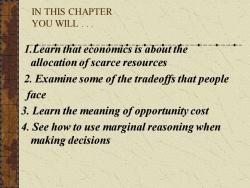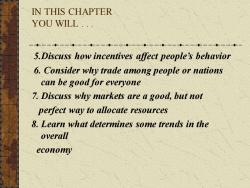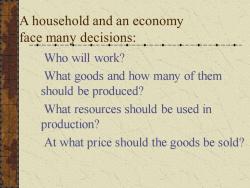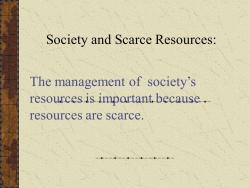《西方经济学》课程教学资源(PPT课件)西方经济学英文讲稿 Western Economics(共二十二章)

Microeconomics +-The Institute'of Econo赤mics and Management-+-· XinJiang University
Microeconomics The Institute of Economics and Management XinJiang University

CONTENTS Chapter 1 Ten Principles of Economics Chapter 2 Thinking Like an Economist Chapter 3 Interdependence and the Gains from Trade Chapter 4 The Market Forces of Supply and Demand Chapter 5 Elasticity and Its Application Chapter6 Supply,Demand and Government Policies Chapter 7 Consumers,Producers,and the Efficiency of Markets Chapter 8 Application:The Costs of Taxation Chapter 9 Application:International Trade Chapter 10 Externalities Chapter 11 Public Goods and Common Resources
CONTENTS Chapter 1 Ten Principles of Economics Chapter 2 Thinking Like an Economist Chapter 3 Interdependence and the Gains from Trade Chapter 4 The Market Forces of Supply and Demand Chapter 5 Elasticity and Its Application Chapter 6 Supply, Demand and Government Policies Chapter 7 Consumers, Producers, and the Efficiency of Markets Chapter 8 Application: The Costs of Taxation Chapter 9 Application: International Trade Chapter 10 Externalities Chapter 11 Public Goods and Common Resources

CONTENTS Chapter 12The Design of the Tax System Chapter 13 The Costs of Production Chapter 14 Firms in Competitive Markets Chapter 15 Monopoly Chapter 16 Oligopoly Chapter 17 Monopolistic Competition Chapter 18 The Economics of Labor Markets Chapter 19 Earnings and Discrimination Chapter 20 Income Inequality and Poverty Chapter 21 The Theory of Consumer Choice Chapter 22 Frontiers of Microeconomics
CONTENTS Chapter 12 The Design of the Tax System Chapter 13 The Costs of Production Chapter 14 Firms in Competitive Markets Chapter 15 Monopoly Chapter 16 Oligopoly Chapter 17 Monopolistic Competition Chapter 18 The Economics of Labor Markets Chapter 19 Earnings and Discrimination Chapter 20 Income Inequality and Poverty Chapter 21 The Theory of Consumer Choice Chapter 22 Frontiers of Microeconomics

Ten Principles of Economics Chapter 1
Ten Principles of Economics Chapter 1

IN THIS CHAPTER YOU WILL. I.Learn that economics is about the allocation ofscarce resources 2.Examine some of the tradeoffs that people face 3.Learn the meaning of opportunity cost 4.See how to use marginal reasoning when making decisions
IN THIS CHAPTER YOU WILL . . . 1.Learn that economics is about the allocation of scarce resources 2. Examine some of the tradeoffs that people face 3. Learn the meaning of opportunity cost 4. See how to use marginal reasoning when making decisions

IN THIS CHAPTER YOU WILL. 5.Discuss how incentives affect people's behavior 6.Consider why trade among people or nations can be good for everyone 7.Discuss why markets are a good,but not perfect way to allocate resources 8.Learn what determines some trends in the overall economy
IN THIS CHAPTER YOU WILL . . . 5.Discuss how incentives affect people’s behavior 6. Consider why trade among people or nations can be good for everyone 7. Discuss why markets are a good, but not perfect way to allocate resources 8. Learn what determines some trends in the overall economy

Economy. The word economy comes from a Greek word for one who manages a household
Economy. . . . . . The word economy comes from a Greek word for “one who manages a household

A household and an economy face many decisions: Who will work? What goods and how many of them should be produced? What resources should be used in production? At what price should the goods be sold?
A household and an economy face many decisions: Who will work? What goods and how many of them should be produced? What resources should be used in production? At what price should the goods be sold?

Society and Scarce Resources: The management of society's resources is important.because. resources are scarce
Society and Scarce Resources: The management of society’s resources is important because resources are scarce

Scarcity. .means that society has limited resources and therefore cannot produce all the goods and services people wish to have
Scarcity . . . . . . means that society has limited resources and therefore cannot produce all the goods and services people wish to have
按次数下载不扣除下载券;
注册用户24小时内重复下载只扣除一次;
顺序:VIP每日次数-->可用次数-->下载券;
- 《西方经济学》课程教学课件(PPT讲稿)微观经济学 Microeconomics,共二十一章.ppt
- 《西方经济学》课程教学资源(教案讲义)微观经济学讲稿.doc
- 新疆大学:《金融学》课程教学课件(PPT讲稿)第四章 金融机构.ppt
- 新疆大学:《金融学》课程教学课件(PPT讲稿)第十章 通货膨胀和通货紧缩.ppt
- 新疆大学:《金融学》课程教学课件(PPT讲稿)第十二章 金融发展、金融监管与金融安全.ppt
- 新疆大学:《金融学》课程教学课件(PPT讲稿)第十一章 货币政策调控.ppt
- 新疆大学:《金融学》课程教学课件(PPT讲稿)第六章 中央银行.ppt
- 新疆大学:《金融学》课程教学课件(PPT讲稿)第八章 货币供给.ppt
- 新疆大学:《金融学》课程教学课件(PPT讲稿)第五章 商业银行.ppt
- 新疆大学:《金融学》课程教学课件(PPT讲稿)第二章 信用、利息与利率.ppt
- 新疆大学:《金融学》课程教学课件(PPT讲稿)第九章 货币均衡.ppt
- 新疆大学:《金融学》课程教学课件(PPT讲稿)第三章 金融市场.ppt
- 新疆大学:《金融学》课程教学课件(PPT讲稿)第七章 货币需求.ppt
- 新疆大学:《金融学》课程教学课件(PPT讲稿)第一章 货币概述.ppt
- 新疆大学:《金融学》课程教学资源(自学大纲,共十二章).doc
- 新疆大学:《金融学》课程各章习题(答案).doc
- 新疆大学:《金融学》课程各章习题(题目).doc
- 《金融学》课程学习指导书(共十二章).doc
- 《金融学》课程教学资源(案例讲义,共七部分).doc
- 新疆大学:《金融学》课程实习实训指导.doc
- 新疆大学:《国际贸易》课程教学大纲(国际经济与贸易专业).pdf
- 新疆大学:《国际贸易》课程授课教案(讲义,负责人:陈晓).doc
- 新疆大学:《国际贸易》课程教学课件(PPT讲稿)第1章 绪论.ppt
- 新疆大学:《国际贸易》课程教学课件(PPT讲稿)第2章 劳动生产率与比较优势——李嘉图模型.ppt
- 新疆大学:《国际贸易》课程教学课件(PPT讲稿)第3章 特定要素和收入分配.ppt
- 新疆大学:《国际贸易》课程教学课件(PPT讲稿)第4章 资源与贸易——赫克歇尔-俄林模型.ppt
- 新疆大学:《国际贸易》课程教学课件(PPT讲稿)第5章 标准贸易模型.ppt
- 新疆大学:《国际贸易》课程教学课件(PPT讲稿)第6章 规模经济、不完全竞争和国际贸易.ppt
- 新疆大学:《国际贸易》课程教学课件(PPT讲稿)第7章 国际要素流动.ppt
- 新疆大学:《国际贸易》课程教学课件(PPT讲稿)第8章 国际贸易政策.ppt
- 新疆大学:《国际贸易》课程教学课件(PPT讲稿)第9章 贸易政策中的政治经济学.ppt
- 新疆大学:《国际贸易》课程教学课件(PPT讲稿)第10章 发展中国家的贸易政策.ppt
- 新疆大学:《国际贸易》课程教学课件(PPT讲稿)第11章 贸易政策论战.ppt
- 石河子大学:《经济地理学》课程教学大纲 Economic Geography(本科生).doc
- 石河子大学:《经济地理学》课程教学大纲 Economic Geography(研究生).doc
- 《经济地理学》课程教学资源(学习资料)名词解释.doc
- 石河子大学:《经济地理学》课程教学资源(学习资料)环境保护与可持续发展学习指南 Environmental Protection and Sustainable Development Turotial.doc
- 石河子大学:《经济地理学》课程教学资源(实验指导)地理信息系统实习指导.doc
- 石河子大学:《经济地理学》课程教学资源(PPT课件)第二章 经济活动区位的影响因素(1/2).ppt
- 石河子大学:《经济地理学》课程教学资源(PPT课件)第一章 绪论(负责人:徐丽萍,主讲:刘月兰).ppt
